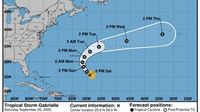Tropical Storm Gabrielle, the seventh named storm of the 2025 Atlantic hurricane season, continued to intensify over the open waters of the central Atlantic through Saturday, September 20, with forecasters predicting it would soon achieve hurricane status. According to the National Hurricane Center (NHC), Gabrielle formed on Wednesday morning, September 17, and by Saturday evening was positioned about 575 miles north-northeast of the northern Leeward Islands and 580 miles southeast of Bermuda. The storm was moving northwest at 10 mph, packing maximum sustained winds of 65 mph, and stretching tropical-storm-force winds outward up to 140 miles from its center.
Forecasters from the NHC and the National Weather Service expected Gabrielle to become a hurricane by late Saturday or Sunday, September 21. David Roth, a forecaster with the National Weather Service, noted that Gabrielle could reach Category 2 hurricane strength, with maximum sustained winds potentially climbing to 105 mph. "They'll notice there are some higher waves Tuesday," Roth said, referring to Bermuda. "On Sunday and Monday their easterly winds might increase some. But it doesn't take much wind to produce rip currents."
Despite its growing strength, Gabrielle was not expected to make landfall or directly impact Bermuda or the U.S. mainland. The NHC’s 5 p.m. ET update on Saturday emphasized that the storm would pass east of Bermuda Sunday night or Monday, missing the island but generating swells that could create life-threatening surf and rip currents. The U.S. East Coast, particularly areas north of North Carolina, as well as Atlantic Canada, were also expected to feel the effects of these swells later in the weekend and into early next week. The NHC warned that rip currents, even from distant storms, are the third-highest cause of hurricane-related deaths, trailing only behind inland flooding and storm surges.
As of Saturday, there were no coastal watches or warnings in effect, but officials in Bermuda were advised to monitor the storm’s progress closely. The NHC also reported that Gabrielle would likely continue its northwest trajectory through Sunday before turning northeast toward the Azores later in the week, remaining over open waters and away from major landmasses.
Gabrielle’s development came roughly a week after what is historically considered the peak of the Atlantic hurricane season, which runs annually from June 1 to November 30 and typically sees the most activity around September 10. The 2025 hurricane season was predicted by the National Oceanic and Atmospheric Administration (NOAA) to be busier than average. In May, NOAA forecasted 13 to 19 named storms, with as many as nine hurricanes and five potentially reaching Category 5 intensity. By early August, this was slightly revised to 13 to 18 named storms and five to nine hurricanes. For context, the previous year saw 18 named storms, 11 of which became hurricanes, and five reached major hurricane status, including the record-setting Category 5 Hurricane Beryl.
Unlike the rapid and early intensification seen in 2024, the 2025 season had one of the slowest starts in two decades, a trend attributed by experts to slightly below-average ocean heat content in the main development region during June. Ocean heat content is a measure of the thermal energy stored in the ocean, and it plays a crucial role in fueling tropical cyclones. Last year’s intense storms were linked to above-average sea surface temperatures, which can drive rapid storm intensification. In contrast, the cooler waters this June may have delayed the onset of major storms, though experts still believe a major hurricane landfall in the U.S. is probable this season.
Satellite imagery has been instrumental in tracking Gabrielle’s development. Meteorologists use these images to assess the storm’s strength, size, and structure. The formation of a symmetrical eye, for example, typically signals that a hurricane is reaching peak intensity and is not being weakened by environmental factors such as wind shear. On Saturday evening, Gabrielle was still battling some wind shear but was expected to enter more favorable conditions, aiding its transition to hurricane status by Sunday.
Damaging winds from Gabrielle have already caused some power outages along its path, though the most significant impacts have been confined to open waters. The NHC has also started providing rip current forecasts this year, in recognition of the significant dangers posed by these currents even from distant storms. Rip currents can catch swimmers off guard, and public advisories aim to raise awareness and prevent unnecessary tragedies.
While Gabrielle is not expected to bring direct impacts to Louisiana or the U.S. mainland, its indirect effects—namely, hazardous surf and rip currents—underscore the far-reaching dangers of Atlantic storms. The NHC has urged residents along the East Coast and in Bermuda to remain vigilant and heed local advisories, even in the absence of direct landfall threats.
Meanwhile, meteorologists are also keeping an eye on an eastern tropical wave off the coast of Africa. According to the NHC, this system has a 0% chance of development in the next 48 hours and a 20% chance over the next seven days as it moves west-northwestward across the central tropical Atlantic. The agency continues to monitor the broader Atlantic basin for signs of additional storm formation as the season progresses.
The broader context of Gabrielle’s development includes growing concerns about climate change and its impact on hurricane behavior. Scientists have warned that a warming world is likely to see storms that intensify more rapidly, produce more rainfall, and linger longer over affected areas. These trends have already been observed in recent years, with record-breaking rainfall events like Hurricane Harvey in 2017 and a noticeable slowdown in the pace of moving storms, which can exacerbate flooding and destruction.
Last year was also one of the costliest in U.S. hurricane history, with Hurricanes Helene and Milton causing a combined $113 billion in damages and more than 250 deaths. The Trump administration’s decision to discontinue the maintenance of a database tracking billion-dollar disasters and reduce staffing at key agencies like NOAA and FEMA has raised concerns among disaster response experts about the nation’s preparedness for future storms.
As the 2025 Atlantic hurricane season continues, the slow start and current activity serve as reminders of the unpredictability and power of these natural phenomena. With Gabrielle poised to become the season’s second hurricane—nearly a month later than the average date for the second hurricane formation—officials and residents alike are urged to stay informed and prepared for whatever the remainder of the season might bring.
With Gabrielle churning far from land but sending powerful waves across the Atlantic, the story of the 2025 hurricane season remains one of watchful anticipation and cautious readiness.






